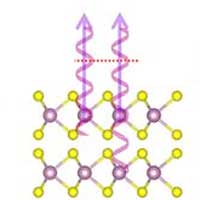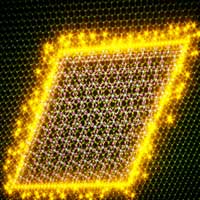 Scientists have taken a step closer to the goal of controlling light by identifying nonlinear optical phenomena occurring in heterobilayers composed of two-dimensional materials.
Scientists have taken a step closer to the goal of controlling light by identifying nonlinear optical phenomena occurring in heterobilayers composed of two-dimensional materials.
Thursday, December 17, 2020
2D material controls light twice stronger
 Scientists have taken a step closer to the goal of controlling light by identifying nonlinear optical phenomena occurring in heterobilayers composed of two-dimensional materials.
Scientists have taken a step closer to the goal of controlling light by identifying nonlinear optical phenomena occurring in heterobilayers composed of two-dimensional materials.
Ultra-thin designer materials unlock quantum phenomena
 A team of theoretical and experimental physicists have designed a new ultra-thin material that they have used to create elusive quantum states. Called one-dimensional Majorana zero energy modes, these quantum states could have a huge impact for quantum computing.
A team of theoretical and experimental physicists have designed a new ultra-thin material that they have used to create elusive quantum states. Called one-dimensional Majorana zero energy modes, these quantum states could have a huge impact for quantum computing.
Ultracold atoms reveal a new type of quantum magnetic behavior
 A new study illuminates surprising choreography among spinning atoms: Researchers reveal how magnetic forces at the quantum, atomic scale affect how atoms orient their spins.
A new study illuminates surprising choreography among spinning atoms: Researchers reveal how magnetic forces at the quantum, atomic scale affect how atoms orient their spins.
Catalyst research: Molecular probes require highly precise calculations
 Scientists have demonstrated the use of calculation methods with so-called hybrid functionals for the reliable interpretation of experimental data.
Scientists have demonstrated the use of calculation methods with so-called hybrid functionals for the reliable interpretation of experimental data.
Polariton interactions: Light matters
 Why do two-dimensional exciton-polaritons interact? The answer is found to lie in the 'light-like' characteristics of these quasiparticles. This is important for future applications using polaritons in atomically-thin semiconductors, such as ultra-low energy electronics.
Why do two-dimensional exciton-polaritons interact? The answer is found to lie in the 'light-like' characteristics of these quasiparticles. This is important for future applications using polaritons in atomically-thin semiconductors, such as ultra-low energy electronics.
Organic molecules on a metal surface... a machinist's best friend
 How can you improve the cutting of 'gummy' metals? Engineers have come up with an answer - and their findings may help in manufacturing products and reducing component failures.
How can you improve the cutting of 'gummy' metals? Engineers have come up with an answer - and their findings may help in manufacturing products and reducing component failures.
Subscribe to:
Comments (Atom)
